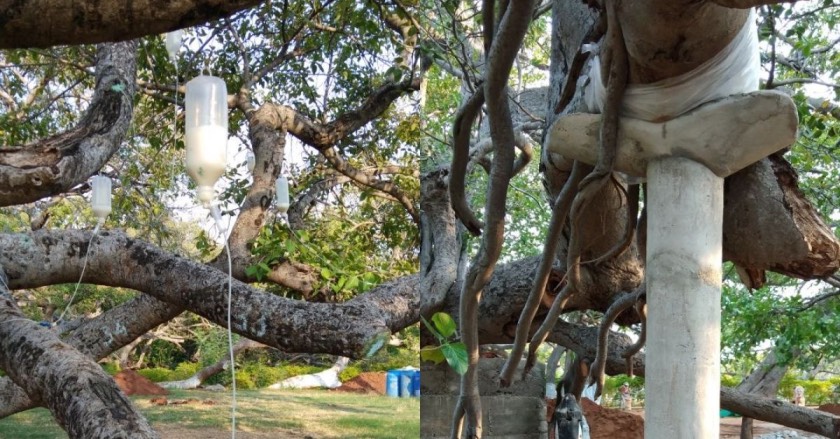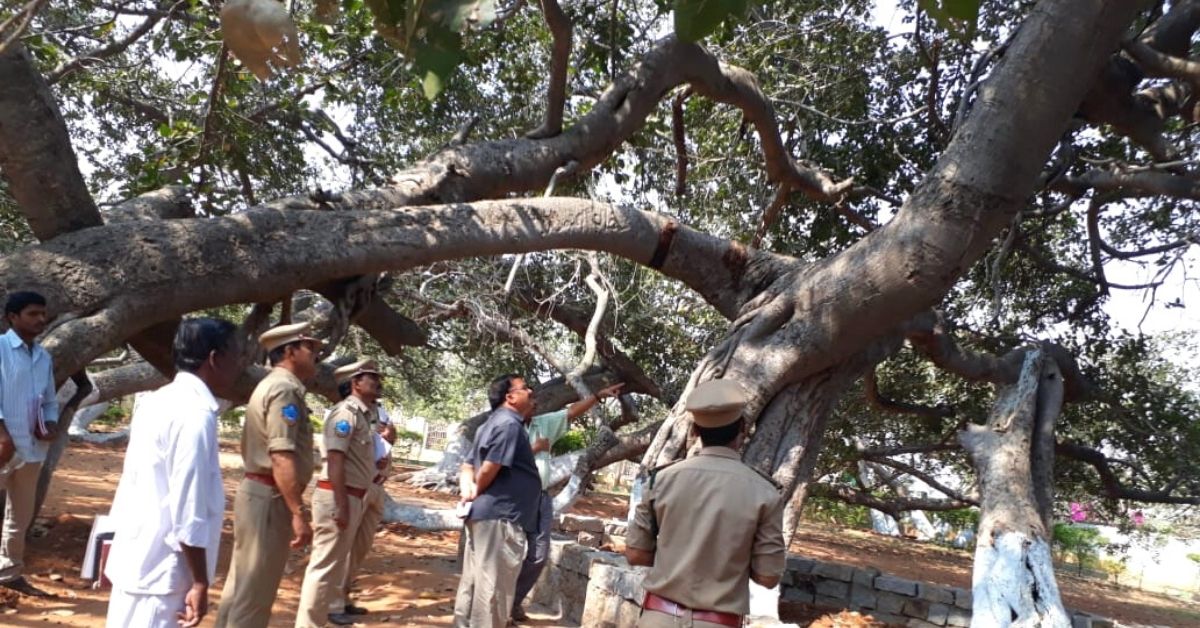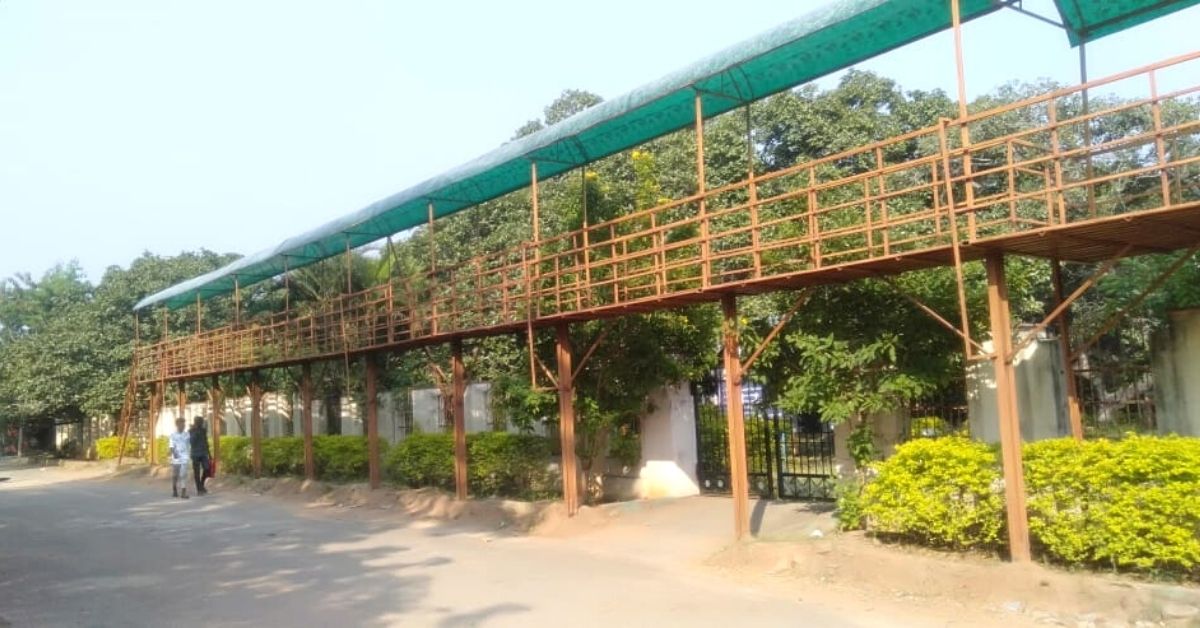Telangana IAS Helps Save 700-YO Banyan Tree After 3 Years of Continuous Effort
In 2017, Ronald Rose, the then district collector of Mahbubnagar, Telangana initiated steps to revive the 13th-century banyan tree after a big trunk infested with termites, collapsed

A canopy and a walkway now installed in the Mahbubnagar district of Telangana—about 100 km from Hyderabad—form a pathway to the grounds of a 700-year-old tree. Hundreds of visitors roam around the vast expanse of the tree, which is spread across a 3.5-acres. This age-old tree is one of the largest banyan trees in India and holds heritage value.
But this marvel of nature has had a painful past. It is only recently that the innumerable drips injected into the various branches of the Pillalamarri Banyan tree have allowed it a new lease on life. After a three-year-long intensive treatment, the great banyan tree of Telangana has been revived from its deathbed and is now sprouting new shoots and leaves.
Saving the ‘pride of Telangana’
In 2017, one of the tree’s massive branches collapsed, signalling its wilting condition brought on by years of neglect and inadequate care by officials.
“The falling of the branch revealed many issues the tree was facing. It was infested with termites. Many of the branches turned hollow with the infection,” says Ronald Rose, the then district collector of Mahbubnagar.

He adds that many experts were called in to intervene and suggest solutions to revive the dying tree. “Along with internal diseases, the tree also faced harm from visitors who vandalised the branches, swung from its roots, making it difficult to grow and affected the overall health of the tree,” Ronald says.
The IAS officer immediately sanctioned funds to bring the necessary solutions to stop its termite infestation. A month after the branch fell, a rigid plan was drawn up for its treatment.
First, the area was cordoned off to quarantine the tree for the planned treatment. The next step was to spray chlorpyrifos all over the infested area. However, a few weeks later, superficial treatment did not seem to reveal any results. The infection was deep-rooted within its branches, “many of which are the size of a truck”.
“We realised that just spraying the chemical solution over the tree’s surface area would not work. More than 500 saline bottles were brought in and injected in the branches of the trees,” Ronald says. Two metre deep bores were then drilled in many parts of the tree, allowing the solution to seep inside the branches to rid it from the termites.
The officials also realised that just one chemical solution would not help. However, the intensive use of chemicals also drew criticism from officials of different sectors, who questioned the course of the treatment.
“The tree needed both chemical and organic treatment. The fresh roots were bonded with organic material like the vermicompost and organic matter filled in jute bags to assist a healthy growth,” he says adding that neem oil also was sprayed as the infection reduced.

The IAS officer adds that longer roots halfway or nearing the ground were surrounded by PVC pipes and filled with the organic matter. About 50 such structures were created surrounding the roots.
Two forest officials and multiple staff from the forest department were assigned to protect and help the tree survive.
Chukka Ganga Reddy, the deputy conservator of forest and district forest officer, says that the tree was under daily care and the smallest of issues were attended to. “To support the weak branches, temporary pillars are erected along with the treatment. The intensive caring in the initial stages helped the tree to improve its health slowly,” Chukka says.
He adds that other issues with the tree were also identified. “It was realised that the tree is water-stressed. There is not enough groundwater for such a huge tree to source hydration and nutrients. A rainwater harvesting system is now installed for the tree,” he says adding that the tree is watered almost daily.
Smaller branches of the tree have now become considerably large so that no mother trunk is identified. The forest officer says that along with watering all the crucial roots, the soil was loosened around them. He adds, “Organic compost, biofertilizers, cow dung, cow urine, ghee and coco-peat were put around these roots to provide the nutrients every fortnight.”
To preserve a banyan tree

It was only after three months of hard work, involving five hours of daily care, watering and close monitoring of the termite infestation, that the first signs of positive response became visible. Fresh leaves and shoots were seen on some branches.
After spending Rs 20 lakh in the past few years, recently, the forest officials announced the tree to be out of danger and claimed that its growth is healthy.
The success also attracted the attention of the Tourism and Culture and Archaeology Minister Sri Srinivas Goud Garu, who paid a visit to the tree.
“The treatment will continue for some more time now until all the roots grow well and are declared as healthy. It is also being ensured that the infection does not return,” Chukka adds.
He says that along with the Herculean task of ensuring the tree survives, a lot of other factors were at stake. “The tree is the pride of Telangana. If we failed, the reputation of the department and the administration would be tarnished. The damage happened to the tree due to the neglect, and we must work on our mistakes,” Chukka tells The Better India.
Tightening the security around the Banyan tree, he says, “The visitors will not be allowed to touch the tree from now on. The walkway is designed in a manner to take visitors to the hidden parts of the trees. The view is now much better to take pictures as well.”
If you found our stories insightful, informative, or even just enjoyable, we invite you to consider making a voluntary payment to support the work we do at The Better India. Your contribution helps us continue producing quality content that educates, inspires, and drives positive change.
Choose one of the payment options below for your contribution-
By paying for the stories you value, you directly contribute to sustaining our efforts focused on making a difference in the world. Together, let’s ensure that impactful stories continue to be told and shared, enriching lives and communities alike.
Thank you for your support. Here are some frequently asked questions you might find helpful to know why you are contributing?


This story made me
-
97
-
121
-
89
-
167













